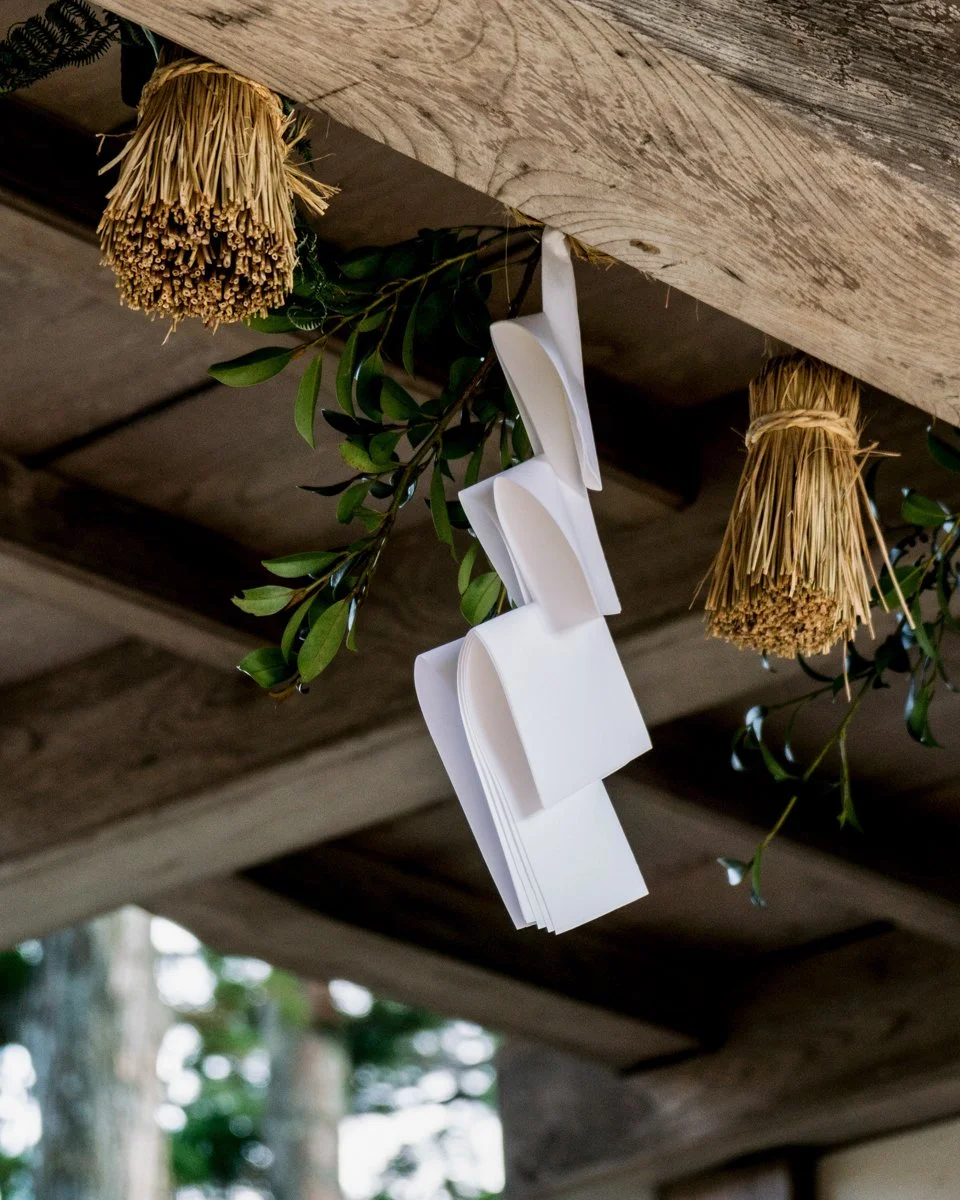








Gorinto a five ringed tower, a stone form of a pagoda often found in Buddhist cemeteries. It represents the Buddhist cosmology .The cube at the bottom symbolizes earth, the sphere - water, the pyramid - fire, the hemisphere - air and the jewel on top - infinity (space/ void). All together, combined, the five elements represent the wisdom that makes up the universe.

Gorinto a five ringed tower, a stone form of a pagoda often found in Buddhist cemeteries. It represents the Buddhist cosmology .The cube at the bottom symbolizes earth, the sphere - water, the pyramid - fire, the hemisphere - air and the jewel on top - infinity (space/ void). All together, combined, the five elements represent the wisdom that makes up the universe.















Branches of sakaki tree decorated with zig-zag strips of washi paper (tamagushi )-- an offering presented to kamis during festivals, celebrations and rituals in Shinto shrines. The ever-green leaves allude to eternity and are believed to ward off evil spirits.






Ritual cleaning (and raking) of sacred grounds at Meji Jingu Shrine in Tokyo, as the day breaks on New Year’s morning. For the Japanese, who revere Amaterasu (the Sun goddess) as their most important deity, the first sunrise of the year (hatsuhinode) holds special significance. So does ritual cleansing and preparation of grounds for deities.












A zigzag-shaped paper streamer used in Shinto rituals to mark sacred spaces. Shide are often attached to shimenawa, which are twisted rice straw ropes that can be found on rocks or gates. The streamers flutter in the wind, symbolizing the connection between nature and the spiritual world. Shide are also used in sweeping rituals called (harai) to remove impurities and spirits.


Omikuji are fortunes written on strips of paper that are available at Buddhist temples and Shinto shrines in Japan. The word "omikuji" translates to "sacred lot". They predict the person's chances of their hopes coming true, of finding a good match, or generally matters of health, fortune, life. When the prediction is bad, it is a custom to fold up the strip of paper and attach it to a pine tree or a wall of metal wires alongside other bad fortunes in the temple or shrine grounds. A purported reason for this custom is a pun on the word for pine tree (松, matsu) and the verb 'to wait' (待つ, matsu), the idea being that the bad luck will wait by the tree rather than attach itself to the bearer. In the event of the fortune being good, the bearer has two options: they can also tie it to the tree or wires so that the fortune has a greater effect or they can keep it for luck. Omikuji are available at many shrines and temples, and remain one of the traditional activities related to shrine or temple-going.





















Jizo, one of Japan’s most beloved gods - a bodhisattva (potential Buddha who remained on Earth to help people attain Buddahood), revered as the guardian of travelers and protector of children. His name can also be translated as Earth’s Womb. Here, photographed on the grounds of Sanzen-in temple in Ohara, he seems almost burried in moss, like a plant.

Stone statute of slender Kannon (female bodhisattva) overgrown with moss. Loved for its fragile beauty and modesty, moss is cherished in Japan as a symbol of resilience and stead-fastness. Because it does not develop roots, it also exemplifies ability to live without attachments –a virtue that Buddhism elevates as a path to enlightenment. Ideally suited to Japan’s humid climate and thriving in the most uninviting environments, moss can often be found in dark forests, gardens, cemeteries, covering trees, rocks and stones.

Stone statute of slender Kannon (female bodhisattva) overgrown with moss. Loved for its fragile beauty and modesty, moss is cherished in Japan as a symbol of resilience and stead-fastness. Because it does not develop roots, it also exemplifies ability to live without attachments –a virtue that Buddhism elevates as a path to enlightenment. Ideally suited to Japan’s humid climate and thriving in the most uninviting environments, moss can often be found in dark forests, gardens, cemeteries, covering trees, rocks and stones.







